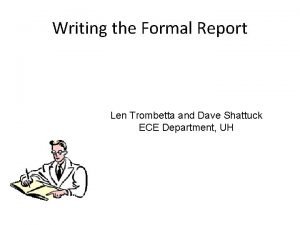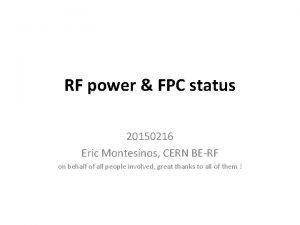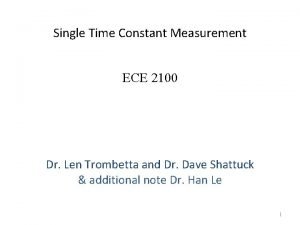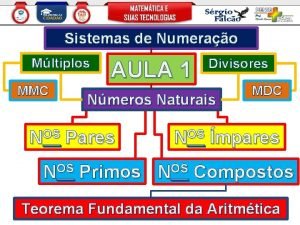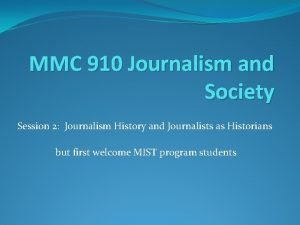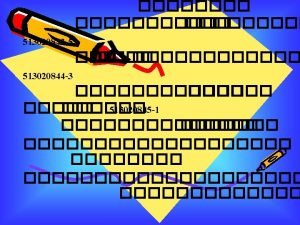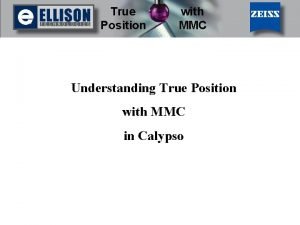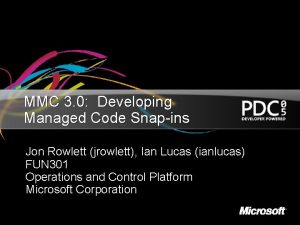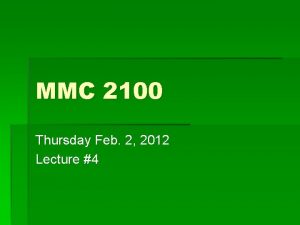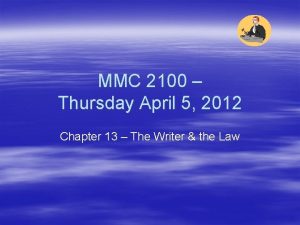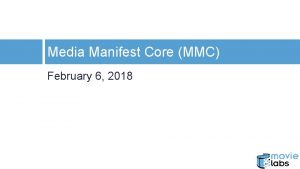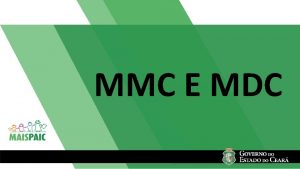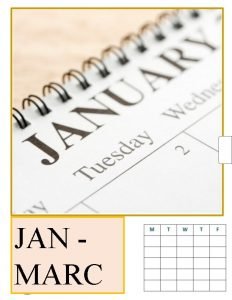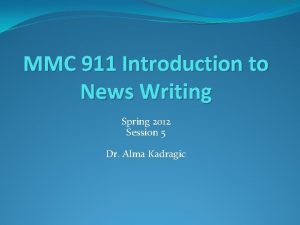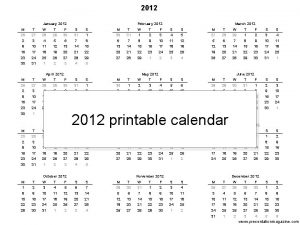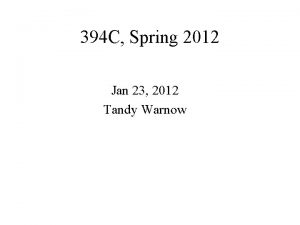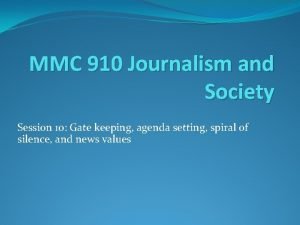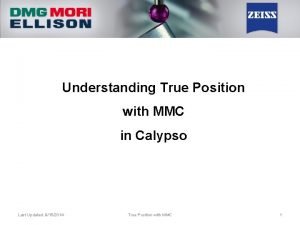MMC 2100 Thursday Jan 19 2012 MMC 2100
























- Slides: 24

MMC 2100 Thursday Jan. 19, 2012

MMC 2100 u Updates – Check blog/sakai several times/week updates u Sakai – under Lessons u www. mmc 2100 ufclass. wordpress. com u Tests: 4 tests throughout semester (3 highest count toward your grade) – NO MAKEUPS

MMC 2100 u Getting ready for Personality Profile – Next week’s guest Kristin Harmel, UF alum, author http: //kristinharmel. com/ u Come with questions u – Personality Profile timeline u Personality profile partners assigned in Lab 3 next week (exchange bio info) u Conduct interview between Labs 3 -4 (starting next week) u Lab 4 (2 weeks): bring personality profile rough draft to lab for MANDATORY 10 -minute “coaching session” with lab instructor u Lab 5: Final personality profile due

MMC 2100 u News story – Lab 2: police brief – Lab 3 (next week): longer news story w quotes/paraphrase w headline u Average 2 grades for ONE overall grade for news story u Begin counting AP Style next week’s lab u Download News Article grading rubric

Rules for writing headlines • Headlines should be based on the main idea of the story • Main idea should be found in the lead or introduction of the story • If facts are not in the story, do not use them in a headline • Avoid repetition • Avoid ambiguity, insinuations and double meanings • If a story qualifies a statement, the headline should also

Rules for writing headlines • Use present tense verbs for headlines that refer to past or present events • For the future tense, use the infinitive form of the verb (such as “to go, ” “to run, ” etc. ) rather than the verb “will” • Alliteration should be deliberate and should not go against the general tone of the story • Do not use articles — “a, ” “an” and “the” • Do not use the conjunction “and”

Rules for writing headlines • Avoid using unclear or little-known names, phrases and abbreviations in headlines • Use punctuation sparingly • No headline may start with a verb • Headlines should be complete sentences or should imply complete sentences • When a linking verb is used, it can be implied rather than spelled out

MMC 2100 headlines u Let’s look at Alligator stories

MMC 2100 u Lengths: possible keep things as short as – 1 -3 sentences/paragraph – 25 -30 words/sentence – Direct quote approximately every four paragraphs

MMC 2100 u Third person – NO: I, YOU, OUR, WE u Don’t editorialize by using adjectives – just state facts

Direct quotations • Avoid them in the lead paragraph • Use them in the rest of the story • Must be accurate • Quotation, speaker, verb • Shorter is better • Use them to support what has already been stated rather than to introduce new information

QUOTES u u Direct quotes: take exact wording of another person and reproduce word for word using quotation marks Direct quote, speaker, verb – EXAMPLE: “This was the best assignment we’ve ever completed, ” Rob Marino said. “The class understood everything. ” – No more than THREE sentences in a direct quote – ID speaker right away – after first sentence the first time they are quoted – Need only one attribution per paragraph DON’T start stories with direct quotes

QUOTES u Commas with Quotes sheet

Paraphrasing u Using your own words to restate another person’s ideas – EXAMPLE: Rob Marino said this was the best assignment of the year based on the students’ comprehension of the topic. USE THIS MORE WHEN QUOTING FACTS AND FIGURES

Ch. 3: Style and the Stylebook u Learning Objective: – What is the AP Stylebook and how it fits into the life of a journalist – Understand some of the major AP Style terms

Ch. 3: Style and the Stylebook u Why AP Stylebook was created? – Form consistent format for all journalists on many commonly-used terms – Updated periodically u Newest section?

Ch. 3: Style and the Stylebook u Commonly used AP headings – Symbols u Always write out percent (percent) – NOT % u Monetary amounts (dollars) – use $ -- like $4 u Days – never abbreviate (days of the week) u Months – only abbreviate when making reference to a specific date (months) – NEVER abbreviate March, April, May, June, July – Spell out when using alone or with only year – January 2012 – Jan. 19, 2012 (no th, nd) – always use figures when referring to specific dates

Ch. 3: Style and the Stylebook u AP Style issues – Titles u First and last name on first reference and then ONLY last name rest of way – NO Mr. or Mrs. Or Miss or Ms. – Capitalization u Uppercase entire title when used BEFORE name: UF President Dr. Bernie Machen u Lowercase common nouns when used AFTER title: Dr. Bernie Machen, the president of UF.

Ch. 3: Style and the Stylebook u Organizations – Write out on first reference unless acronym is well known: FBI, CIA

Ch. 3: Style and the Stylebook u Places – Only abbreviate states when using a specific city (state names) u Use abbreviation list – NOT ZIP CODE u Don’t abbreviate Alaska, Hawaii, Idaho, Iowa, Maine, Ohio, Texas, Utah u PUNCTUATION: comma between city and state and again after state: Ocala, Fla. , is a nice place.

Ch. 3: Style and the Stylebook u Addresses (addresses) – Abbreviate ONLY Avenue (Ave. ), Boulevard (Blvd. ) and Street (St. ) when used with a SPECIFIC address (ABS) u 5053 Atlantic Ave. u What about? The 500 block of Atlantic Avenue – All other words (drive, road, etc. ) always spelled out – Use figures for an address: 5053 Atlantic Ave. – Spell out and capitalize First through Ninth when used as a street name; use figures for 10 th and above – Abbreviate compass points ONLY with a SPECIFIC address u 430 E. 52 nd Ave. – specific u The 400 block of East 52 nd Avenue – not specific

Ch. 3: Style and the Stylebook u Numbers (numerals) (OTHER USES) – Spell out: one-nine (EXCEPT in dates and addresses): There are three ways to look at the problem. – Use numerals: 10 -above u There are 10 ways to look at the problem. – Ages (ages) u Always use figures: Fred Smith, 52, is the president of the club u Use hyphens if age used as adjective – A 5 -year-old boy.

Ch. 3: Style and the Stylebook u Times (times) – Use figures (except noon, midnight) – but better to say 12 p. m. or 12 a. m. – No colons on full hours: 11 a. m. – Avoid redundancies u The class starts at 5 p. m. this afternoon.

AP Style u Appendix A: Copy-Editing Symbols – Also in back of AP Stylebook u AP Style Resource Sheet u Sections 3. 7, 3. 8, 3. 9 (back of Chapter 3)
 Homework
Homework What is formal report
What is formal report Ece 2100
Ece 2100 Cgs 2100
Cgs 2100 Eric montesinos
Eric montesinos Genamin kdmp inci
Genamin kdmp inci 2100-2008
2100-2008 Wr-2100 waveguide
Wr-2100 waveguide Weltbevölkerung
Weltbevölkerung Ece 2100
Ece 2100 Inventarmontør
Inventarmontør Factors of 2100
Factors of 2100 Qu blackboard
Qu blackboard O sistema de numeração romana hoje em desuso
O sistema de numeração romana hoje em desuso Mmc xray
Mmc xray Mot tesla coil
Mot tesla coil Open mmc
Open mmc Mmc vsware
Mmc vsware Mmc
Mmc Mmc
Mmc Maximum material condition example
Maximum material condition example Mmc plus
Mmc plus True position mmc
True position mmc Dataflow mmc
Dataflow mmc Mmc 3
Mmc 3

